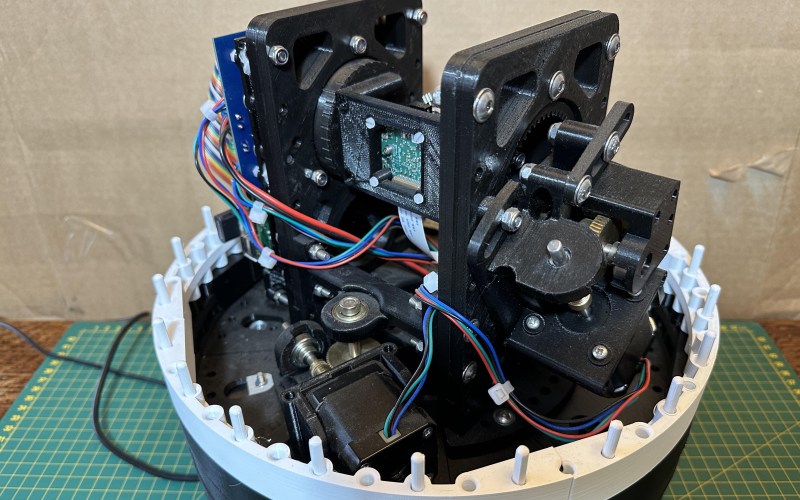Humans have loved looking up at the night sky for time immemorial, and that hasn’t stopped today. [MattHh] has taken this love to the next level with the Pi-lomar Miniature Observatory.
Built with a Raspberry Pi 4, a RPi Hi Quality camera, and a Pimoroni Tiny2040, this tiny observatory does a solid job of letting you observe the night sky from the comfort of your sofa (some assembly required). The current version of Pi-lomar uses a 16mm ‘telephoto’ lens and the built-in camera libraries from Raspbian Buster. This gives a field of view of approximately 21 degrees of the sky.
While small for an observatory, there are still 4 spools of 3D printing filament in the five different assemblies: the Foundation, the Platform, the Tower, the Gearboxes and the Dome. Two NEMA 17 motors are directed by the Tiny2040 to keep the motion smoother than if the RPi 4 was running them directly. The observatory isn’t waterproof, so if you make your own, don’t leave it out in the rain.
If you’re curious how we might combat the growing spectre of light pollution to better our nighttime observations, check out how blinking can help. And if you want to build a (much) larger telescope, how about using the Sun as a gravitational lens?

















This project is made by a cousin of Sponge Bob Square Pants since the coordinates are well inside the North Sea. And is not warm enough for the real SBSP.
Now build a model of the telescope itself—the framework structure, the big horseshoe mount—with a scale-sized mirror. No other optics needed, mount a sensor at the prime focus, where there’s a cage for a human to sit and observe directly.
A few minor challenges. Gotta rewrite the software for an equatorial motion rather than alt-az motion. Probably have to grind and polish the mirror yourself….have it aluminized….little things like that….
“The problem with great ideas is that they devolve into a lot of hard work” — the Great and Wise Sage Called Anonymous
:-)
Hard agree on EQ vs ALT/AZ, EQ will allow tracking of celestial objects without field rotation, allowing very long exposures.
You could always mount the pi-lomar on a wedge to easily change it from ALT/AZ to EQ without needing to change the original design.
There’s an opensource project called EQ mod which turns a skywalker motorised HEQ mount into a beast of a mount with insane motor driving (I think they use wave-driven stepper motors) that increases the gearing ratio, might give someone inspiration to tackle the EQ stuff in software?
I’ve seen some really great work in astrophotography with “just” a telescope in a driveway in the suburbs. I say “just” because it’s doing active tracking and a ton of post processing but wow do they get some great pics of gas clouds.
You’re right though, primary observation is tough and I still haven’t been able to see the aurora borealis at my latitude because the whole sky is aglow from the city 30 miles away.
Just musing here, 35 mm Zoom lenses (IMHO) are more plentiful and reasonably priced.